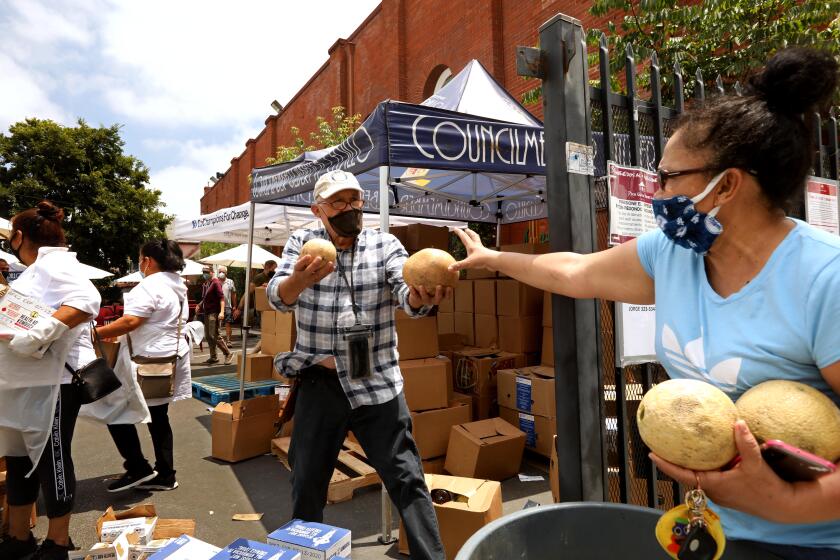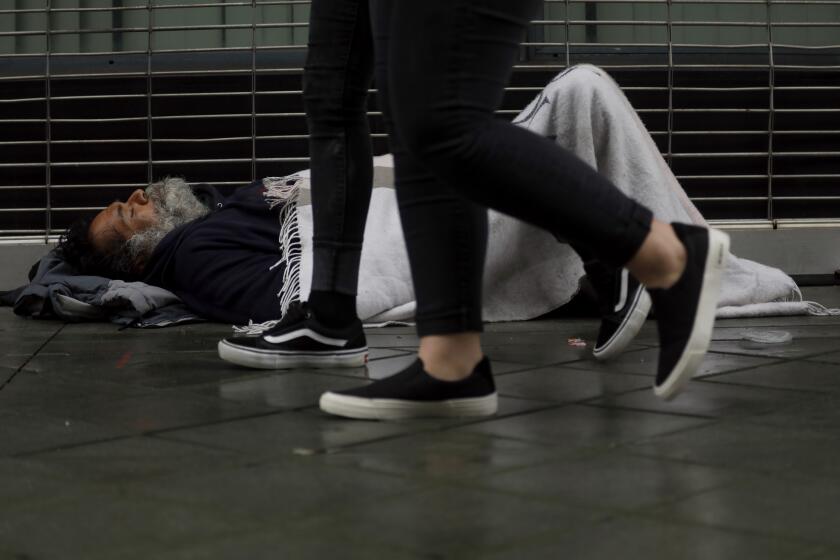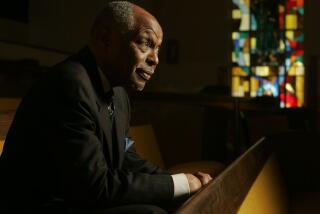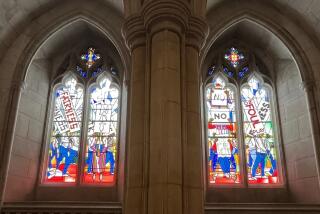A Black woman sat on the grass outside an L.A. church. The cold welcome she recorded speaks volumes
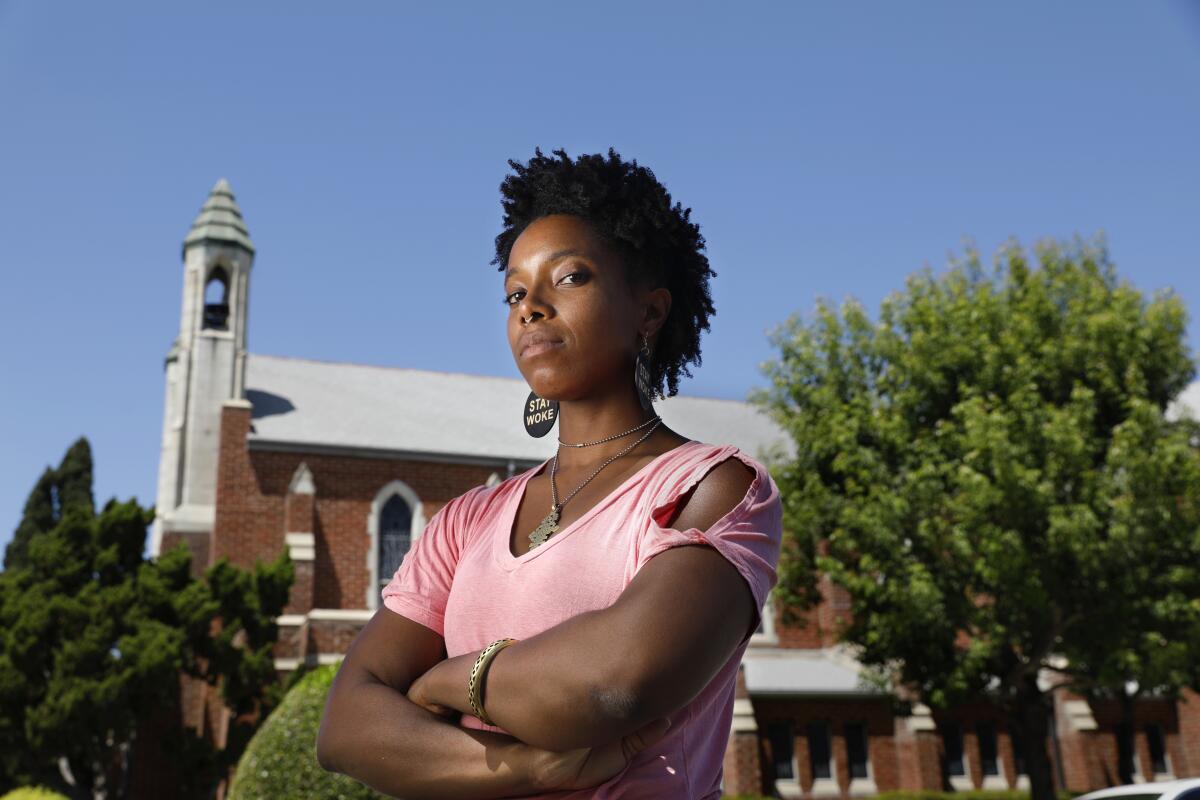
- Share via
The story I’m about to tell you began one hot afternoon this week on the lawn of an L.A. church, where a young Black woman sought peace in the leafy shade of a tree to paint her toenails emerald green and do some laptop research on a road trip she planned to take to the Grand Canyon.
Once I tell you what happened next, I urge you to watch for yourself — because Alex Marshall-Brown, who is an actress and stuntwoman, expertly documented in her own words and on video the distinctly unwelcoming and assumption-laden response to her presence demonstrated by members of North Hollywood’s St. Paul’s First Lutheran Church.
That their shameful behavior, which she soon would post on Facebook, might rapidly spread across social media and go viral seems either not to have occurred to or not to have bothered the white church members she filmed.
Even though they were older, that is striking, given that we are living in a moment when much of the nation is grappling with a growing awareness of how white people in this country for centuries have routinely treated Black people in ways that have led to grave inequality and injustice and even, all too frequently, to death.
Marshall-Brown, who has lived in the church’s neighborhood for years, had been sitting on its lush green lawn for less than 15 minutes on Tuesday, she told me, when a pair of what appeared to be bicycle cops rolled up. She noticed the yellow-shirted “safety ambassadors” from the North Hollywood Business Improvement District but at first paid them no mind — until one of them stood in front of her and the other at her side, at which point, she said, “my spidey sense is going wild.”
When one of the men told her that she was on private property, she calmly pointed out that she was outside a church, on a lawn with no fence or “No Trespassing” sign. They stayed put. She stayed put, continuing to paint her nails. Before they rode off, she asked them what would happen next, and they told her that if she did not leave, someone likely would call the police.
Marshall-Brown, wondering who had made the first call, then noticed women in the windows of the church’s preschool across the street, clearly monitoring her without looking at her directly. Then one came out and, without speaking, walked behind her to check that the church doors were locked.
Soon after, two older white men appeared on the church property, cutting across the lawn straight to her side of the tree. One held a “No Trespassing” sign and a power tool. Neither said anything to her.
Each time I watch the video, that realization hits me like a gut punch — that these people from a church were dehumanizing her by treating her as an other, to be dispensed with without so much as a “How do you do?”
On the video, it is Marshall-Brown who speaks first.
“Hello,” she says, to which the man with the sign and power tool replies, “Welcome.”
“Am I?” she asks, to which he replies, “No.”
Each time I watch, I feel queasily certain that my presence on the lawn would not have elicited any such response — simply because of the color of my skin.
Again, watch the footage for yourself. Watch the man obliquely refer to the homeless people in the neighborhood by telling Marshall-Brown that the church has “a lot of problems with people here from the park vandalizing.”
Watch him, as he screws in the sign, say, “When people aren’t nice, we’re not nice,” and answer her query about why he thinks she has “been unkind” with the words: “Ma’am. We have to treat everybody the same. All lives matter.”
“All lives matter.” Think about that. Think about the coded ways people try to couch their true meaning in words they hope will give their thoughts cover but don’t.
It’s a coding that continues to appear on the video as an older woman from the preschool appears and starts filming Marshall-Brown, talking about the need to protect the children because of people who show up on the property, and “you don’t know what they’re going to do.”
Love-your-neighbor was the drive behind a grass-roots project in a poor L.A. community. It’s much harder than it looks.
It’s a coding that particularly bothered two of Marshall-Brown’s friends, Thaddeus Shafer and Kari Lee Cartwright, who were among those who showed up at the church to support her after she posted the video. Shafer put a shorter version on TikTok, where it quickly got noticed. Well over 2 million people have seen Shafer’s versions of the footage.
It’s still far less widely known than the viral video of a white woman named Amy Cooper calling the cops on Christian Cooper, a Black birdwatcher in New York’s Central Park. But it might not be for long, because in a lot of ways, the two encounters are strikingly similar.
The church members threaten to bring in the police and show no compunction about the potential danger that could come from doing so. They don’t appear to take in Marshall-Brown’s clearly stated argument that their behavior is “in excess of anything that needs to happen.” They seem certain — in a way that is alien to many people who are not white — of their solid authoritative standing with authorities.
Marshall-Brown’s friend Shafer, who met her when they acted in a play together, said the man in the video’s out-of-nowhere use of the words “All lives matter,” when Marshall-Brown had said nothing about Black Lives Matter, was particularly disturbing.
“You want to say, ‘Don’t you know that “all lives matter” is not a good statement, that Black Lives Matter is a plea for help from an oppressed community?’”
Marshall-Brown, by the way, is the daughter of a foreign service officer. She spent time living with him around the world, in Barbados and Guyana and Lesotho. Her father, who grew up in Watts, talked to her often about civil rights. She has always been engaged, she told me, but she hasn’t been an activist.
Since the death of George Floyd and the ensuing protests — which she chose not to attend because of the pandemic health risks — she has posted frequently on social media about how to point people who don’t get it in the direction of anti-racism, urging friends and allies not to shut them out but rather to try to open a meaningful dialogue with them.
She told me that, like every Black person, she has experienced racist behavior countless times, at home and abroad, though it’s not in her nature to spend time cataloging slights.
Her encounter with the church people this week profoundly shook her, she said. She felt enormous anger at the injustice of it and at first urged people who saw the video to call out the church publicly. But her ultimate goal in this moment is to do what she’s been preaching to others — to push to make what happened change thinking, both in the church that was unwelcoming to her and beyond.
On her Facebook page, she told people to contact the church “with a more nuanced, compassionate messaging” because church members had reached out to her and listened.
The day after the incident occurred, the church issued an apology on Facebook for the actions of the people in the video, described as “volunteer and nonvolunteer workers.” The volunteers, the church said, had agreed to step down from their roles. The next day, when Marshall-Brown and friends and supporters came back to St. Paul’s, the church school’s acting principal, Santiago Botero, who also plays a leading role in the church, and Bettina Winfrey, a longtime church member and a preschool parent, invited them into the sanctuary to talk.
Winfrey told me she felt “blind rage” when she first saw the video. She spoke of the churn within her as Marshall-Brown both described the pain she experienced in the encounter and voiced her hope that what happened to her would lead the congregation to serious self-examination and change.
“I found myself in tears, because she was so gracious, and I felt that we did not deserve that,” Winfrey said of the church, adding that she has spent too long literally and figuratively “sitting in the back pew,” not doing the work she should as one of the younger generation to help move the congregation forward.
At last count, more than 36,000 homeless people were living in Los Angeles, nearly 59,000 in the county. But how can we actually help the homeless? What practical aid can we offer?
Marshall-Brown and I had spoken at length about the fear that seemed to be the real force behind the church members’ extreme reaction to her presence on the lawn. She had told me about the growing homeless population in the area, including the adjacent park.
Winfrey confirmed this and said there had been incidents on the property — including vandalism, people defecating on the lawn and mentally ill people acting erratically. But like Marshall-Brown, she told me she hoped the church in the future would stop barricading itself out of fear and instead reach out more to those in need in the community out of compassion. She thought what happened this week could help.
“I truly, truly believe that God put her on our lawn for a reason,” Winfrey said of Marshall-Brown.
I might put that differently, but I share her hope that the story I’ve just told you will be only the beginning.
More to Read
Sign up for Essential California
The most important California stories and recommendations in your inbox every morning.
You may occasionally receive promotional content from the Los Angeles Times.
